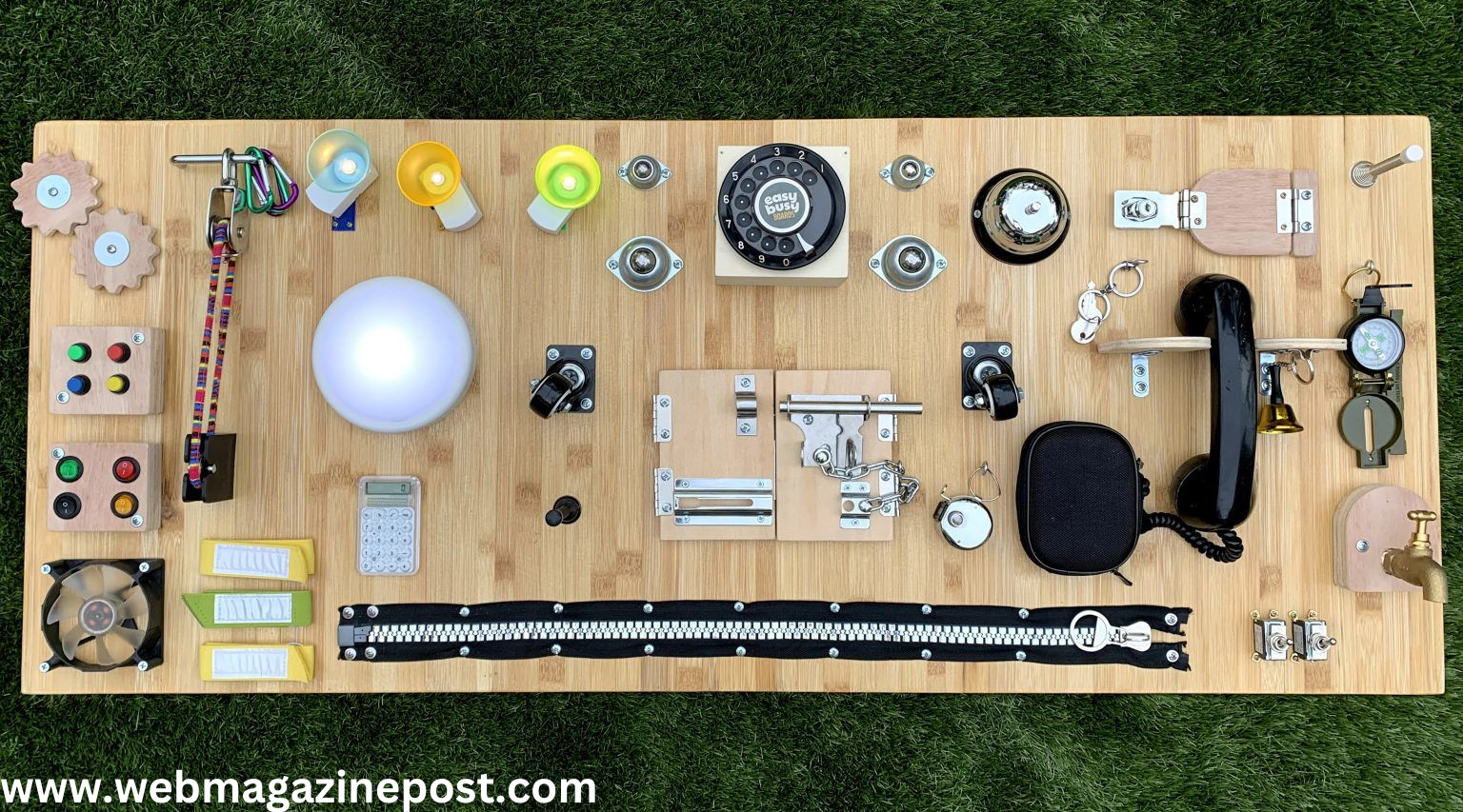
The Ultimate Guide to Busy Boards: 100% Must-Have for Child Development
What is a Busy Board?
Definition and Overview
A busy board is a sensory activity board filled with various interactive elements such as locks, buttons, zippers, switches, and other small objects. These boards are designed to keep children engaged by allowing them to explore different textures, sounds, and movements. Often handcrafted, baseboards provide a hands-on experience that stimulates a child’s senses and supports their cognitive and motor skill development.
History of Busy Boards
Busy boards have been around for decades, inspired by the idea of offering children safe access to everyday objects. They originated from the Montessori educational approach, which emphasizes hands-on learning and sensory exploration. Over the years, baseboards have evolved to include a wider variety of elements, making them suitable for a broader range of developmental needs.
Why Are Busy Boards Important for Child Development?
Cognitive Development
Busy boards play a significant role in cognitive development. As children interact with various elements on the board, they learn cause and effect, problem-solving, and logical thinking. For instance, turning a switch on and off teaches them how mechanisms work, while matching colors or shapes helps with pattern recognition.
Fine Motor Skills
One of the most notable benefits of busyboards is the enhancement of fine motor skills. Activities like turning knobs, pulling levers, and twisting locks require precision and hand-eye coordination, which are essential for writing, dressing, and other daily tasks. These small but significant movements strengthen the muscles in a child’s hands and fingers.
Sensory Exploration
Busy boards are rich in sensory experiences, allowing children to explore different textures, sounds, and visual stimuli. This sensory exploration is crucial for brain development as it helps children understand the world around them. By engaging multiple senses simultaneously, baseboards provide a holistic learning experience.
Types of Busy Boards
DIY Busy Boards
For parents who enjoy crafting, DIY baseboards offer a personalized and budget-friendly option. These boards can be tailored to fit a child’s specific interests and developmental needs. Creating a DIY baseboard also allows parents to reuse household items, making it an eco-friendly project.
Pre-Made Busy Boards
Pre-made busy boards are readily available online and in stores, offering convenience for busy parents. These boards often feature professionally designed layouts and a variety of activities that are tested for safety and educational value. While more expensive than DIY versions, they save time and effort.
Themed Busy Boards
Themed busy boards focus on specific interests or educational goals, such as numbers, letters, or nature. These boards are great for reinforcing particular skills or knowledge, such as counting or recognizing animals, and can be a fun way to align with a child’s current interests.
Key Features of an Effective Busy Board
Variety of Activities
An effective busy board should offer a range of activities that challenge different skills. Including a mix of fine motor tasks, sensory elements, and problem-solving activities keeps the board engaging and ensures that children are continuously learning.
Safety Considerations
When it comes to busyboards, safety is the top priority. All parts should be securely attached, and small pieces should be avoided to prevent choking hazards. It’s also important to use non-toxic materials, especially for younger children who are likely to put objects in their mouths.
Age Appropriateness
The design and complexity of a busyboard should match the child’s age and developmental stage. For infants, simpler boards with large, easy-to-manipulate elements are best, while toddlers and older children can handle more complex boards with smaller, intricate parts.
How to Choose the Right Busy Board for Your Child
Considering Age and Interests
When selecting a busy board, consider the child’s age and current interests. A board that aligns with their curiosity will keep them engaged longer. For example, if your child is fascinated by animals, a nature-themed busyboard might be the perfect choice.
Balancing Fun and Education
While busy boards are designed to be fun, it’s important to choose one that also has educational value. Look for boards that incorporate elements of learning, such as numbers, letters, or problem-solving tasks, to maximize developmental benefits.
Portability and Size
If you need a busyboard that can be easily transported, consider its size and weight. Portable busyboards are great for travel or moving between rooms in the house. Smaller boards can be just as engaging if they are well-designed.
Step-by-Step Guide to Creating Your Own Busy Board
Materials Needed
To create a DIY baseboard, gather materials such as a sturdy wooden board, screws, nails, sandpaper, and various items like locks, zippers, buttons, and wheels. You can also add colorful paint, fabric, and other sensory materials.
Design Planning
Start by sketching a layout of your busyboard. Consider the placement of each item and ensure there’s a balance between different types of activities. Make sure the board is not overcrowded, allowing each element to stand out and be easily accessible.
Assembly Instructions
Once your design is ready, begin by sanding the board to ensure there are no rough edges. Then, attach the various elements using screws or strong adhesive. Ensure everything is securely fastened and test each part to ensure it works smoothly.
Popular Busy Board Themes
Nature-Themed Boards
Nature-themed busyboards feature elements like leaves, animals, and outdoor textures. These boards often include items like faux grass, wooden animals, and pictures of nature scenes, making them perfect for kids who love the outdoors.
Alphabet and Numbers Boards
For children learning to read and count, alphabet and numbers boards are a great choice. These boards typically include letters, numbers, and related activities like counting beads or tracing letters with their fingers.
Sensory-Specific Boards
Sensory-specific busyboards are designed to target particular senses, such as touch, sight, or sound. These boards might include textured fabrics, musical elements, or bright colors to stimulate a child’s senses in focused ways.
Safety Tips for Busy Boards
Avoiding Choking Hazards
Always avoid small parts that could be detached and swallowed. For younger children, it’s crucial to ensure that all elements are too large to fit into their mouths and that they are securely fastened.
Securing Loose Parts
Regularly check your busyboard for any loose parts. As children play, some elements may become loose, which could pose a safety risk. Tighten screws and replace any worn-out parts to keep the board safe.
Regular Maintenance
Busy boards require occasional maintenance to ensure they remain safe and functional. Inspect the board regularly for any wear and tear, and replace or repair parts as needed to maintain safety and usability.
Incorporating Busy Boards into Daily Routines
Integrating into Playtime
Busy boards are a fantastic addition to daily playtime. They can be used as a standalone activity or integrated into a broader play session with other toys. The key is to allow the child to explore the board at their own pace.
Educational Use at Home
Use busy boards as a tool for home-based learning. They can reinforce lessons from school or introduce new concepts in a hands-on way, making learning fun and interactive.
Busy Boards in Early Education Settings
Many early education centers incorporate busyboards into their classrooms. These boards provide a break from traditional learning methods and allow children to engage in self-directed play, which is essential for early childhood development.
The Role of Busy Boards in Montessori Education
Aligning with Montessori Principles
Busy boards align well with Montessori principles, which emphasize independence, hands-on learning, and sensory exploration. These boards encourage children to experiment and learn at their own pace, which is a core aspect of the Montessori method.
Promoting Independence and Exploration
By offering a range of activities, baseboards allow children to explore independently. This not only builds confidence but also nurtures a sense of curiosity and a love for learning.
Top Busy Board Brands and Recommendations
Reviewing Popular Brands
There are several reputable brands that offer high-quality baseboards. Brands like Little Learning Hands, KiddoLab, and Baby Einstein are known for their safe, durable, and educational busyboards.
Customer Reviews and Feedback
Before purchasing a busyboard, it’s a good idea to read customer reviews. Look for feedback on durability, safety, and how engaging the board is for children of different ages.
Busy Boards for Special Needs Children
Customizing for Sensory Processing Disorders
Busy boards can be customized to meet the needs of children with sensory processing disorders. By selecting specific textures, sounds, and activities, these boards can provide therapeutic benefits and help with sensory integration.
Therapeutic Benefits
For children with special needs, busyboards can serve as a therapeutic tool. They can help with focus, calmness, and fine motor skills, providing a safe space for sensory exploration.
Conclusion
Busy boards are more than just a toy—they’re a powerful tool for early childhood development. By engaging children’s senses, enhancing fine motor skills, and promoting cognitive development, these boards offer countless educational benefits. Whether you choose to buy a pre-made board or create your own, incorporating a baseboard into your child’s routine can provide hours of fun and learning.
FAQs About Busy Boards
What age is best for a busy board?
Busy boards are suitable for children aged 6 months to 5 years, with different types of boards catering to specific age groups.
Can busyboards be dangerous?
If not designed and maintained properly, busyboards can pose risks, such as choking hazards or sharp edges. Always prioritize safety by choosing or creating a board with securely attached, non-toxic elements.
How do I clean a busyboard?
Busyboards can be cleaned with a damp cloth. For boards with fabric or other porous materials, spot cleaning is recommended. Regular cleaning helps maintain hygiene, especially for younger children who might mouth the elements.
Are busyboards suitable for travel?
Yes, portable busyboards are available and are great for keeping children entertained during travel. Choose lightweight and compact designs for easy portability.
How long should a child use a busyboard?
Children can use a busyboard as long as it remains engaging to them, typically until around age 5. As they grow, more complex boards can be introduced to match their developing skills.


